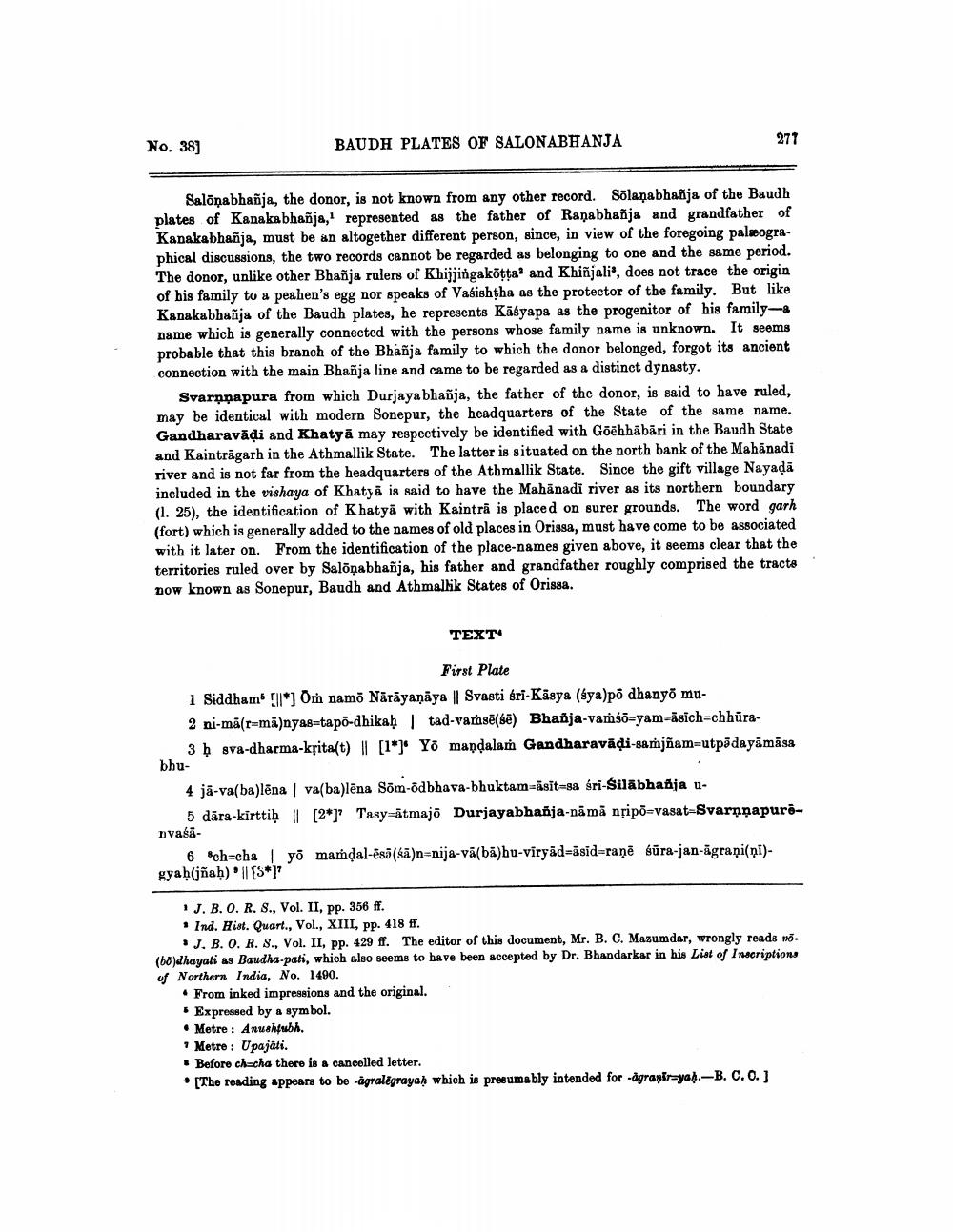________________
No. 38]
BAUDH PLATES OF SALONABHANJA
Salōnabhanja, the donor, is not known from any other record. Sōlanabhañja of the Baudh plates of Kanakabhañja, represented as the father of Ranabhañja and grandfather of Kanakabhañja, must be an altogether different person, since, in view of the foregoing palaeographical discussions, the two records cannot be regarded as belonging to one and the same period. The donor, unlike other Bhañja rulers of Khijjingakōṭṭa and Khiñjali', does not trace the origin of his family to a peahen's egg nor speaks of Vasishtha as the protector of the family. But like Kanakabhañja of the Baudh plates, he represents Kasyapa as the progenitor of his family-a name which is generally connected with the persons whose family name is unknown. It seems probable that this branch of the Bhañja family to which the donor belonged, forgot its ancient connection with the main Bhañja line and came to be regarded as a distinct dynasty.
Svarppapura from which Durjaya bhañja, the father of the donor, is said to have ruled, may be identical with modern Sonepur, the headquarters of the State of the same name. Gandharavadi and Khatyā may respectively be identified with Gōehhābāri in the Baudh State and Kainträgarh in the Athmallik State. The latter is situated on the north bank of the Mahanadi river and is not far from the headquarters of the Athmallik State. Since the gift village Nayaḍā included in the vishaya of Khatya is said to have the Mahanadi river as its northern boundary (1. 25), the identification of Khatyä with Kaintra is placed on surer grounds. The word garh (fort) which is generally added to the names of old places in Orissa, must have come to be associated with it later on. From the identification of the place-names given above, it seems clear that the territories ruled over by Salōnabhañja, his father and grandfather roughly comprised the tracts now known as Sonepur, Baudh and Athmallik States of Orissa.
TEXT'
277
First Plate
1 Siddham [*] Om namo Nārāyaṇāya || Svasti śri-Kasya (sya)po dhanyo mu
2 ni-mr-mi)nyas-tap-dhikab
tad-raal() Bhanja-vah-yam-sich-chhüra
3 sva-dharma-krita(t) || [1] Yō mandalam Gandharavāḍi-samjñam-utpadayāmāsa
bhu
4 jā-va(ba)lēna | va(ba)lēna Sōm-ōdbhava-bhuktam-äsit-sa śri-Silābhañja u
5 dāra-kirttiḥ || [2] Tasy-atmajo Durjayabhañja-nāmā nṛipo-vasat-Svarppapuronvasã
6 ch-cha yo mamḍal-esa (sa)n=nija-vā(bā)hu-viryad-asid-ranē sūra-jan-agraņi(ni)gyaḥ(jñaḥ)||[*]"
Expressed by a symbol.
Metre: Anushiubh,
1 J. B. O. R. S., Vol. II, pp. 356 ff.
Ind. Hist. Quart., Vol., XIII, pp. 418 ff.
J. B. O. R. S., Vol. II, pp. 429 ff. The editor of this document, Mr. B. C. Mazumdar, wrongly reads no(bo)dhayati as Baudha-pati, which also seems to have been accepted by Dr. Bhandarkar in his List of Inscriptions of Northern India, No. 1490.
From inked impressions and the original.
7 Metre: Upajati.
Before ch-cha there is a cancelled letter.
[The reading appears to be -agralegrayah which is presumably intended for -agrayir-yaḥ.-B. C. O. ]




